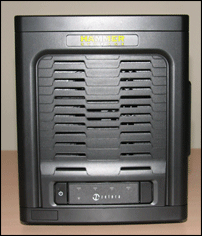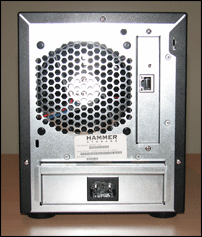SMB NAS Roundup
by Ross Whitehead Jason Clark Dave Muysson on December 5, 2006 3:30 AM EST- Posted in
- IT Computing
Hammer Z-Box
The Hammer is a unique option in this space and is vastly different than the other devices in this article. The Hammer is essentially an entry level IP SAN, where a device driver on the client writes to the disk using block-level I/O instead of file-level I/O. One of the main differences between the Hammer and a traditional IP SAN is that the Hammer uses its own proprietary software driver vs. the iSCSI specification. We at many points in the article pondered whether this device fits in, and determined that it does due to its price point and the fact that it is still marketed as a NAS competitor.
How it works
The Hammer uses a software based initiator which handles all the I/O communication with the device and transmits it over UDP. As we alluded to above, the I/O commands are not simple file level requests; they are actually block-level. Some caveats to this approach are that it requires a fair amount of processing power on the client, and each client will require the software driver.
The Z-Box supports four types of RAID: 0, 1, 0+1, and 10. One item to note is that while the chosen RAID configuration is stored on the box, the client software handles the actual data "RAIDing", not the device itself. Unlike most NAS devices, the Z-Box is expandable. Each disk in the array gets an IP address, and you can daisy chain multiple devices together and create stripes and mirrors across any group of disks you like. For the average home user, this technology is not very useful. But, to a small or medium business looking for relatively cheap IP based storage this is an attractive option.
The Hammer comes with a single gigabit Ethernet port on the rear of the device and four hot-swap SATA drive bays The file system is either Z-FS (Zetera File System) or NTFS, so in case you haven't noticed this device is windows only. Z-FS is a custom file system that supports multi-user access and is licensed from DataPlow.
The chassis itself is quite small and has a rugged industrial look to it. Dimensions for the unit are 162mm (W) x 190mm (H) x 325mm (D), and it weighs in at 9Kg. The front panel consists of a few LEDs: one for each disk and one power. The rear of the unit houses one gigabit network port and the power supply.
Admin Interface
The management interface for the Hammer is client-side, since the device is just a target housing disks. We were somewhat unimpressed by the client-side administration of the device. Using the management software was somewhat cumbersome, especially creating volumes. When creating a volume the end user has to calculate how large the volume should be and how much space from each disk to use, which is far from intuitive.
Pros
The Hammer is a unique option in this space and is vastly different than the other devices in this article. The Hammer is essentially an entry level IP SAN, where a device driver on the client writes to the disk using block-level I/O instead of file-level I/O. One of the main differences between the Hammer and a traditional IP SAN is that the Hammer uses its own proprietary software driver vs. the iSCSI specification. We at many points in the article pondered whether this device fits in, and determined that it does due to its price point and the fact that it is still marketed as a NAS competitor.
How it works
The Hammer uses a software based initiator which handles all the I/O communication with the device and transmits it over UDP. As we alluded to above, the I/O commands are not simple file level requests; they are actually block-level. Some caveats to this approach are that it requires a fair amount of processing power on the client, and each client will require the software driver.
The Z-Box supports four types of RAID: 0, 1, 0+1, and 10. One item to note is that while the chosen RAID configuration is stored on the box, the client software handles the actual data "RAIDing", not the device itself. Unlike most NAS devices, the Z-Box is expandable. Each disk in the array gets an IP address, and you can daisy chain multiple devices together and create stripes and mirrors across any group of disks you like. For the average home user, this technology is not very useful. But, to a small or medium business looking for relatively cheap IP based storage this is an attractive option.
The Hammer comes with a single gigabit Ethernet port on the rear of the device and four hot-swap SATA drive bays The file system is either Z-FS (Zetera File System) or NTFS, so in case you haven't noticed this device is windows only. Z-FS is a custom file system that supports multi-user access and is licensed from DataPlow.
The chassis itself is quite small and has a rugged industrial look to it. Dimensions for the unit are 162mm (W) x 190mm (H) x 325mm (D), and it weighs in at 9Kg. The front panel consists of a few LEDs: one for each disk and one power. The rear of the unit houses one gigabit network port and the power supply.
 Rear |
 Front |
| Click to enlarge | |
Admin Interface
The management interface for the Hammer is client-side, since the device is just a target housing disks. We were somewhat unimpressed by the client-side administration of the device. Using the management software was somewhat cumbersome, especially creating volumes. When creating a volume the end user has to calculate how large the volume should be and how much space from each disk to use, which is far from intuitive.
Pros
- Very fast
- Small footprint
- Very quiet
- High CPU usage on the client
- Supposed to compete with a NAS, but lacks a lot of functionality found in the various NAS products like media streaming.










23 Comments
View All Comments
yyrkoon - Friday, December 8, 2006 - link
My problem is this: I want redundancy, but I also do not want to be limited to GbE transfer rates. I've been in communication with many people, via different channels (email, IRC, forums, etc), and the best results I've seen anyone get on GbE is around 90MB/s using specific NIC cards (Intel pro series, PCI-E).The options here are rather limited. I like Linux, however, I refuse to use Ethernet channel bonding (thus forcing the use of Linux on all my machines), or possibly a combination of Ethernet channel bonding, with a very expensive 802.11 a/d switch. 10GbE is is an option, but is way out of my price range, and 4GB FC doesn't seem to be much better. From my limited understanding of their product, Intel pro cards I think come with software to be used in aggregate load balancing, but I'm not 100% sure of this, and unless I used cross over cables from one machine, to another, I would be forced into paying $300usd or possibly more for a 802.11 a/d switch again. I've looked into all these options, plus 1394b firewire teaming, and SATA port multipliers. Port multiplier technology looks promising, but is Dependant on motherboard RAID (unless you shell out for a HBA), but from what I do know about it, you couldn't just plug it in to a Areca card, and have it work at full performance (someone correct me if I'm wrong please, Id love top learn otherwise).
My goal, is to have a reliable storage solution, with minimal wait times when transferring files. At some point, having too much would be overkill, and this also needs to be realized.
peternelson - Tuesday, December 12, 2006 - link
It sounds like your needs would be solved by using a fiber channel fabric.
You need a FC nic (or two) in each of your clients, then one or more FC switches eg from Brocade or oems of their switches. Finally you need drive arrays to connect FC or regular drives onto the FC fabric.
It isn't cheap but gives fantastic redundancy. FC speeds are 1/2/4 Gigabits per second.
yyrkoon - Tuesday, December 5, 2006 - link
I've been giving Areca a lot of thought lately. What I was considering, was to use a complete system for storage, loads of disk space, with an Areca RAID controller. The only problem I personally have with my idea here is: how do I get a fast link to the desktop PC ?I've been debating back and forth with a friend of mine about using firewire. From what he says, you can use multiple firewire links, teamed, along with some "hack" ? for raising to get 1394b to 1000MBit/s, to achieve what seems like outstanding performance. Assuming what my friend says is accurate, you could easily team 4x 1394b ports, and get 500MB/s.